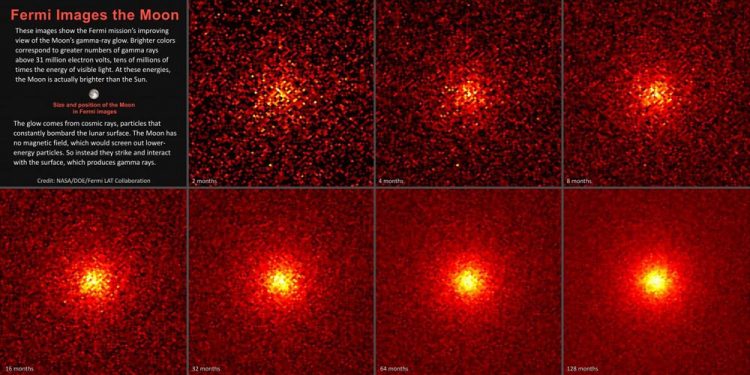Moon glows brighter than sun in images from NASA's Fermi

These images show the steadily improving view of the Moon's gamma-ray glow from NASA's Fermi Gamma-ray Space Telescope. Each 5-by-5-degree image is centered on the Moon and shows gamma rays with energies above 31 million electron volts, or tens of millions of times that of visible light. At these energies, the Moon is actually brighter than the Sun. Brighter colors indicate greater numbers of gamma rays. This image sequence shows how longer exposure, ranging from two to 128 months (10.7 years), improved the view. Credit: NASA/DOE/Fermi LAT Collaboration
Gamma-ray observations are not sensitive enough to clearly see the shape of the Moon's disk or any surface features. Instead, Fermi's Large Area Telescope (LAT) detects a prominent glow centered on the Moon's position in the sky.
Mario Nicola Mazziotta and Francesco Loparco, both at Italy's National Institute of Nuclear Physics in Bari, have been analyzing the Moon's gamma-ray glow as a way of better understanding another type of radiation from space: fast-moving particles called cosmic rays.
“Cosmic rays are mostly protons accelerated by some of the most energetic phenomena in the universe, like the blast waves of exploding stars and jets produced when matter falls into black holes,” explained Mazziotta.
Because the particles are electrically charged, they're strongly affected by magnetic fields, which the Moon lacks. As a result, even low-energy cosmic rays can reach the surface, turning the Moon into a handy space-based particle detector. When cosmic rays strike, they interact with the powdery surface of the Moon, called the regolith, to produce gamma-ray emission. The Moon absorbs most of these gamma rays, but some of them escape.
Mazziotta and Loparco analyzed Fermi LAT lunar observations to show how the view has improved during the mission. They rounded up data for gamma rays with energies above 31 million electron volts — more than 10 million times greater than the energy of visible light — and organized them over time, showing how longer exposures improve the view.
“Seen at these energies, the Moon would never go through its monthly cycle of phases and would always look full,” said Loparco.
As NASA sets its sights on sending humans to the Moon by 2024 through the Artemis program, with the eventual goal of sending astronauts to Mars, understanding various aspects of the lunar environment take on new importance. These gamma-ray observations are a reminder that astronauts on the Moon will require protection from the same cosmic rays that produce this high-energy gamma radiation.
While the Moon's gamma-ray glow is surprising and impressive, the Sun does shine brighter in gamma rays with energies higher than 1 billion electron volts. Cosmic rays with lower energies do not reach the Sun because its powerful magnetic field screens them out. But much more energetic cosmic rays can penetrate this magnetic shield and strike the Sun's denser atmosphere, producing gamma rays that can reach Fermi.
Although the gamma-ray Moon doesn't show a monthly cycle of phases, its brightness does change over time. Fermi LAT data show that the Moon's brightness varies by about 20% over the Sun's 11-year activity cycle. Variations in the intensity of the Sun's magnetic field during the cycle change the rate of cosmic rays reaching the Moon, altering the production of gamma rays.
Media Contact
All latest news from the category: Physics and Astronomy
This area deals with the fundamental laws and building blocks of nature and how they interact, the properties and the behavior of matter, and research into space and time and their structures.
innovations-report provides in-depth reports and articles on subjects such as astrophysics, laser technologies, nuclear, quantum, particle and solid-state physics, nanotechnologies, planetary research and findings (Mars, Venus) and developments related to the Hubble Telescope.
Newest articles

Trotting robots reveal emergence of animal gait transitions
A four-legged robot trained with machine learning by EPFL researchers has learned to avoid falls by spontaneously switching between walking, trotting, and pronking – a milestone for roboticists as well…

Innovation promises to prevent power pole-top fires
Engineers in Australia have found a new way to make power-pole insulators resistant to fire and electrical sparking, promising to prevent dangerous pole-top fires and reduce blackouts. Pole-top fires pose…

Possible alternative to antibiotics produced by bacteria
Antibacterial substance from staphylococci discovered with new mechanism of action against natural competitors. Many bacteria produce substances to gain an advantage over competitors in their highly competitive natural environment. Researchers…





















